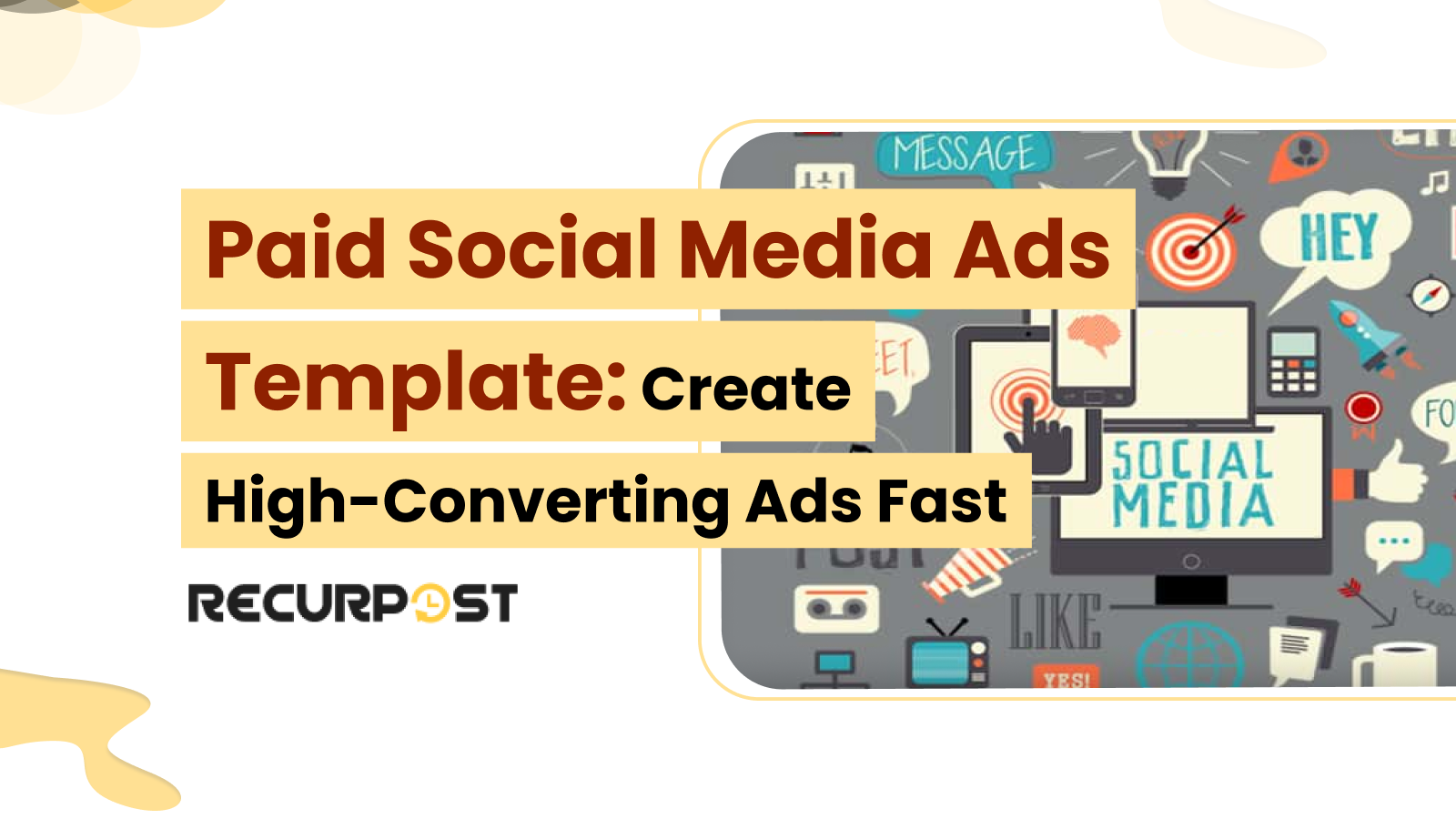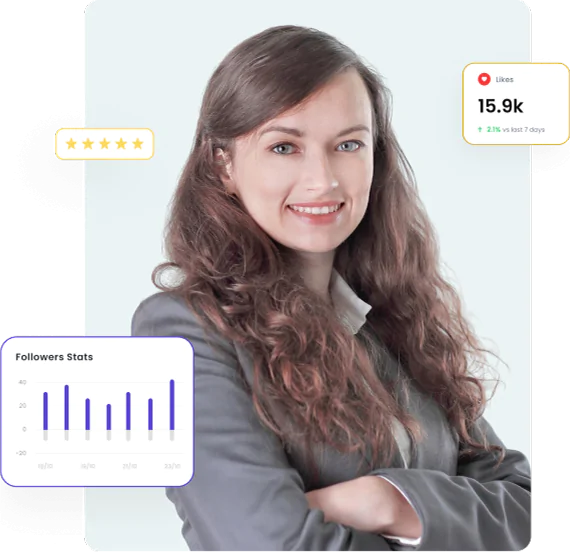Running paid social media ads is still one of the quickest ways to drive clicks, attract leads, and boost conversions across platforms. Building each ad from scratch slows everything down. A paid social media ads template takes that stress off your plate.
RecurPost brings it all together. You get customizable templates and smart scheduling in one place to manage your paid social media advertising alongside your organic posts. These templates help agencies, social media managers, and brands stay consistent and track ad performance with ease.
Here’s what this paid social media ads template guide covers:
- What is a paid social media ads template?
- Why templates improve paid advertising results
- Best ad formats and guidelines by platform
- How to build a reusable social media advertising template
- Tools that help boost ad performance over time
With this, you can skip repetitive design tasks and launch high-converting campaigns quickly, no matter the platform.
What is a Paid Social Media Ads Template?
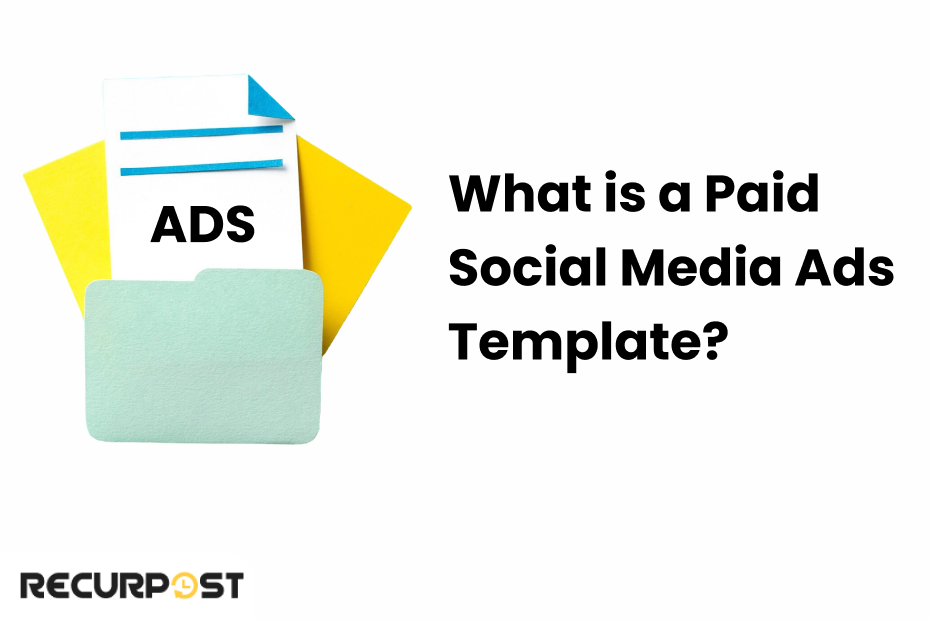
A paid social media ads template gives you a ready-made layout to build ads for platforms like Facebook, Instagram, LinkedIn, and TikTok. Instead of starting from scratch, you get a shortcut: just plug in your visuals and message. You’ll find free, platform-specific versions, like a Facebook ad template, an Instagram story ad layout, or a LinkedIn sponsored content frame—that speed up production and keep things on-brand.
Key Components of a Paid Social Media Ads Template
- Ad copy sections: headline, short text, and a clear call-to-action
- Visual elements: space for videos, images, and text overlays
- Formatting for each platform: correct sizes, word limits, and media types
- Brand details: logo space, consistent colors, and fonts
- Ad objective tags: for clicks, reach, leads, or conversions
With a flexible paid social media ads template, teams can reuse layouts, edit quickly, and present campaign ideas clearly, whether you’re showing a concept to a client or walking through a media buying plan.
You can grab a free paid social media ads template to kick things off fast.
Paid Social Media Ads Template

Why Use a Paid Social Media Ads Template?
Building ads from scratch drains time and energy. A paid social media ads template gives structure that speeds up production and keeps your brand aligned across platforms. You can reuse layouts, tweak them, and test different ad styles without starting over every time. Whether you’re advertising on Facebook, Instagram, LinkedIn, or TikTok, these templates keep things simple and consistent. You can also plug results into a social media report template to track success across all platforms.
Here’s why these templates work so well for busy marketers:
1. Cuts Time and Repetition
Running multiple campaigns? Templates remove the repetitive work so your team can scale faster.
2. Built for Results
They’re shaped around ad practices that lift click-through rates and drive better engagement.
3. Keeps Branding on Point
Templates hold your colors, fonts, and tone steady, no matter which platform you’re using.
4. Easy to Adjust for Any Platform
Just tweak the layout to fit Facebook, Instagram, TikTok, LinkedIn, or YouTube formats and you’re ready to go.
Latest Trends in Paid Social Media Ads for 2025
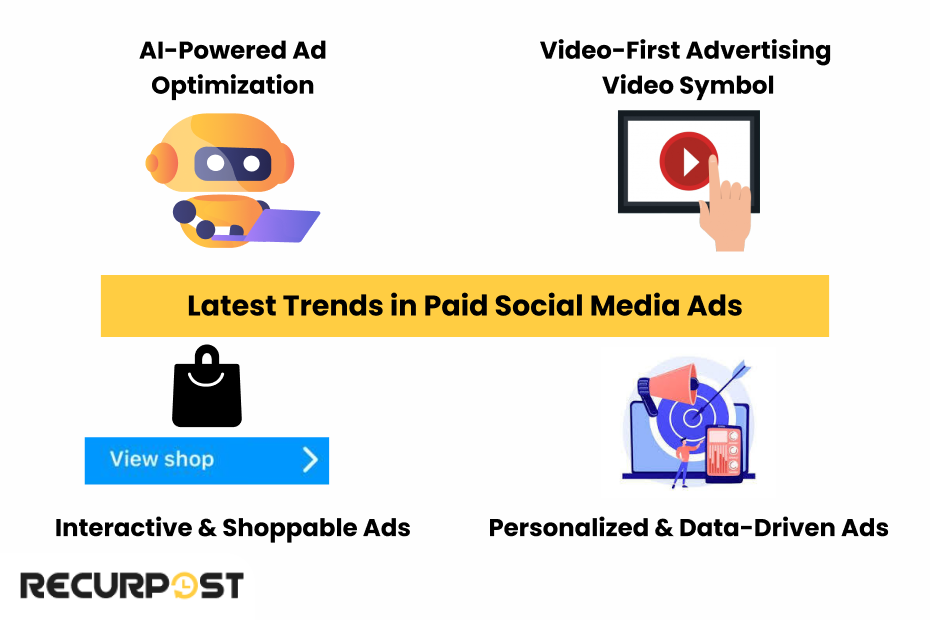
Paid social media ads are shifting fast: AI tools, new formats, and smarter targeting now shape how brands connect with users. Platforms like Meta, TikTok, LinkedIn, and YouTube keep rolling out updates, so staying sharp is key if you want your ads to land.
Here’s what’s trending and how to plug it into your paid social media ads template:
1. Smarter with AI
Meta, Google, and TikTok now use AI to test and adjust ad performance in real-time. A dynamic ad template lets you swap creatives and reach the right people faster.
2. Video Comes First
Reels, Shorts, and TikToks beat out static posts. Your social media templates should focus on short-form video that’s easy to view on mobile.
3. Ads That Sell
Shoppable formats are taking off. TikTok and Instagram now place buy buttons right in the video. Use templates with clear CTAs for these formats.
4. Built Around Behavior
Templates that pull in data like past clicks or shopping habits can lift engagement. A data-driven ad layout makes your message hit home.
Learn How to Measure Social Media Engagement
How to Create a Paid Social Media Ads Template?
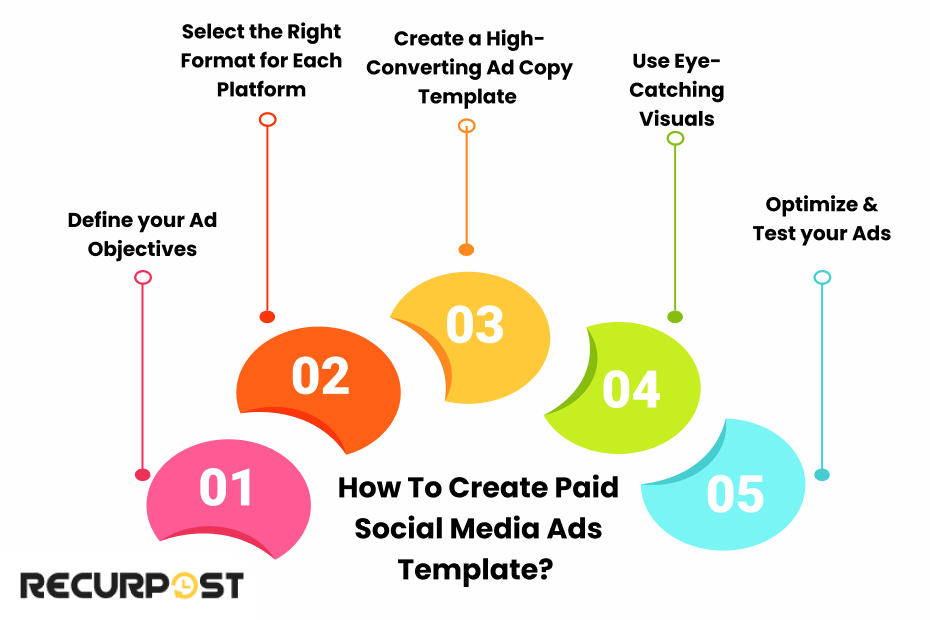
To make a paid social media ads template work, it needs to be built for clicks, conversions, and repeat use. That means more than a good design. It should match each platform’s style and your audience’s habits.
Follow these steps to build a flexible, high-converting ad template that works across your paid campaigns:
Step 1: Pick Your Goal
Start by choosing what you want from the ad:
- Brand Awareness: get seen by more people
- Lead Generation: collect sign-ups or contact details
- Conversions: push sales or app installs
Example: Running lead-gen ads? Your social media template should use strong CTAs like “Get a Free Consultation.”
Step 2: Match the Format
Each platform needs a different layout. Your template should fit these common formats:
Facebook & Instagram
- Single Image (1080×1080)
- Carousel (scrollable slides)
- Short Video (15–60 seconds, 4:5)
- Stories (full-screen mobile)
- Sponsored Content (feed posts)
- Text Ads (small banners)
- InMail (private messages)
TikTok & YouTube
- Vertical Videos (1080×1920)
- In-Feed Auto-Play
- Hashtag Campaigns (interactive)
Tip: Your ad template should accommodate different formats so it can be used across social media platforms.
Step 3: Build the Copy Template
Every great ad needs clean, clear copy. Use this simple flow:
- Hook: grab attention fast
“Struggling to Get Leads?”
- Value: why they should care
“Triple your leads with our proven tools.”
- CTA: what to do next
“Book your free strategy call.”
Tip: Keep it short. Under 125 characters works best on mobile.
Step 4: Use the Right Visuals
Match your creative to the platform:
- Facebook/Instagram: bold images with little text
- LinkedIn: clean, business-focused designs
- TikTok/Reels: snappy videos under 15 seconds
Step 5: Test and Tweak
Run quick A/B tests inside your paid social media ads template:
- Try different headlines: “50% Off Today” vs. “Claim Your Discount”
- Swap static images for video
- Move the CTA to the top or bottom
Tip: Small tweaks can lift performance, so build your template to be flexible and test-ready.
Measure & Optimize Paid Online Ads
Once your paid social media ads template is live, you’ll want to see how it performs. Keep an eye on these simple but powerful metrics:
1. Click-Through Rate (CTR): Shows how many people saw your ad and clicked. Higher CTR means your message hit the mark.
2. Cost Per Click (CPC): Tells you what each click costs. Lower is better. It means you’re getting more value for your spend.
3. Conversion Rate: Measures how many users took action, like signing up or buying. This shows how well your ad turns interest into results.
4. Return on Ad Spend (ROAS): How much money you made for every dollar spent. If you spent $100 and made $400, your ROAS is 4x.
Use these numbers to tweak your template, try new formats, or update your paid ads strategy. Even small changes can lead to stronger results.
Rapid Ad Performance Optimization Techniques
Want fast ad performance gains?
Use these quick fixes to track results and adjust your campaigns on the fly. Your paid social media ads template should leave room for testing and changes like these.
Same-Day Adjustments (First 24 Hours):
- Pause any ad set with a CTR under 1%
- Boost budget 20–30% on high-performing creatives
- Shift targeting based on early audience behavior
- Swap out low-response visuals using your dynamic ad template
Weekly Boosts to Campaign Performance:
- Refresh creatives every 3–5 days to avoid ad fatigue
- Try new audiences based on who’s clicking
- Shift your ad schedule to peak hours
- Add retargeting for recent site visitors (within 7 days)
Quick Wins by Platform:
- TikTok: Post with trending hashtags for instant reach
- Facebook: Let auto-placement speed up learning
- Instagram: Switch to short-form video for higher engagement
- LinkedIn: Target job titles, not industries, for better matchups
Tools That Help You Track Performance:
1. Facebook Ads Manager: control Meta campaigns
2. Google Analytics: check site conversions
3. TikTok Ads Manager: watch short-form ad performance
4. RecurPost Analytics: compare paid vs. organic results, and track engagement in one dashboard
Final Thoughts
good paid social media ads template helps you move faster, stay consistent, and build better ads without the extra workload. With the right layout, sharp visuals, and ongoing testing, you’ll spend less time building and more time running campaigns that work.
Ready to see real results? Start using paid social media ads templates today and make every post count.
Start Using Free Social Media Templates for Businesses
Frequently Asked Questions
1. How can I adapt a paid social media ads template for seasonal campaigns?
Use seasonal colors, visuals, and themes like winter tones or summer graphics. Add time-limited offers and run your ads during peak traffic to stay visible.
2. What mistakes should I avoid with ad templates?
– Using the same layout for every campaign
– Ignoring platform rules (like image sizes or text limits)
– Skipping A/B tests
– Cramming too much text into visuals, especially on Facebook and Instagram
3. Can I automate a paid social media ads template?
Yes. Use tools like Meta Ads Manager, Google Performance Max, or AdEspresso to build, test, and schedule campaigns automatically.
4. What makes a call-to-action (CTA) work?
Clear verbs: Get My Free Trial > Sign Up
Urgency: Limited Time Only!
Platform-fit: Swipe Up for Stories
Obvious value: Claim 10% Off Today
5. How do I stay within platform rules?
– Stick to text/image limits (like Facebook’s 20% text rule)
– Avoid clickbait or exaggerated claims
– Use quality visuals and clean language
– Double-check each platform’s ad guidelines before launch
6. Can I reuse my paid ad template for organic posts?
You can, but make changes. Drop the hard sell and focus on connection. Use ideas that work well for your social media content calendar or daily posts.
7. How do I test if my template is working?
Try different versions, such as headline A vs. B, image 1 vs. 2. Then track CTR, conversion rate, CPC, and ROAS to see what performs best.
8. How can I make my ads more engaging?
– Use scroll-stopping visuals or short-form video
– Keep the text short and mobile-friendly
– Try polls, UGC, or interactive elements
– Match the message to your audience’s interests
9. Do different industries need different templates?
Yes. E-commerce ads often show pricing. B2B might highlight case studies. Local businesses should mention locations. Choose based on what matters most to your buyers.
10. What’s the best way to track success?
Use Meta Ads Manager, Google Analytics, or RecurPost Analytics to measure CTR, conversion rate, and other core metrics—all from one dashboard.

Ruchi Dhimar is a skilled content writer with 5 years of experience. She is passionate about crafting compelling narratives, specializing in writing content for different industries.

